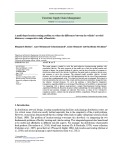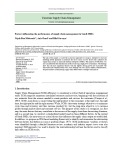
ISSN: 2615-9740
JOURNAL OF TECHNICAL EDUCATION SCIENCE
Ho Chi Minh City University of Technology and Education
Website: https://jte.edu.vn
Email: jte@hcmute.edu.vn
JTE, Volume 19, Issue 06, 2024
75
Optimal Coordination of Directional Overcurrent Protection Relays Using
Genetic Algorithm
Minh Khoa Ngo*, Van Trong Huynh , Hoang Long Vo , Thi Nha Han Pham
Quy Nhon University, Vietnam
*Corresponding author. Email: ngominhkhoa@qnu.edu.vn
ARTICLE INFO
ABSTRACT
Received:
24/10/2024
This paper studies on establishing the mathematical optimization
formulation to coordinate the operating times of directional overcurrent
relays in transmission networks. The objective function of this optimization
formulation is to minimize the total operation time of all directional
overcurrent relays, and it must satisfy the highly nonlinear constraints such
as the time multiplier setting range, the plug setting range, and the
coordination time interval between the primary and backup relay pair. The
optimal variables consist of the time multiplier setting and the plug setting
which are determined by applying the genetic algorithm on MATLAB
software. This optimization formulation is evaluated and validated via the
simulation results of the test systems including the 4-bus network and 9-
bus network. These test systems are modeled and simulated by using
PowerWorld software to calculate the power flow results in the steady state
and the short-circuit currents flowing the primary/backup relay pair. The
simulation results confirm that the operating time coordination of
directional overcurrent relays is capable of meeting the requirements of a
relay protection system, improving the reliability of power system.
Revised:
14/11/2024
Accepted:
26/11/2024
Published:
28/12/2024
KEYWORDS
Coordination time;
Directional overcurrent relay;
Genetic algorithm;
Inverse-time characteristics;
Transmission network.
Doi: https://doi.org/10.54644/jte.2024.1706
Copyright © JTE. This is an open access article distributed under the terms and conditions of the Creative Commons Attribution-NonCommercial 4.0
International License which permits unrestricted use, distribution, and reproduction in any medium for non-commercial purpose, provided the original work is
properly cited.
1. Introduction
The relay protection systems play a vital role in ensuring the power system security and stability,
especially the power grids integrated with distributed generations and microgrids. The traditional relays
with fixed settings have some difficulties in many different operating conditions, therefore, the adaptive
relay protection systems become a necessary issue. Nowadays, digital overcurrent relays enable to make
new protection methods, improving the selectivity, sensitivity, and reliability of the systems. The
adaptive protection helps to detect and isolate rapidly, responding the strict requirements of modern
power systems [1].
Directional protection relays are important devices in power systems with main functions of
determining the short-circuit current direction, they will then isolate the faulty sections rapidly and
correctly. The directional overcurrent protection relays help to enhance the sensitivity and speed of the
protection system, especially in complex power systems integrated with distributed generations. The
published works proposed many directional overcurrent relay time coordination to optimize the relay
operation times and mitigate mis-operation actions of the protection system [2], [3], [4]. Furthermore,
the standard characteristics of digital relays are also considered and evaluated to respond modern power
system requirements [5].
The adaptive directional overcurrent relay protection method automatically adjusts the settings based
on the transmission network configuration changes and operation conditions [6]. This method helps to
enhance the sensitivity and overcome the distributed generation faults in smart grids [7]. The
optimization methods such as the particle swarm optimization, search box optimization and improved
heap-based algorithm were used to optimize the coordination time between the directional overcurrent
relays and distance relays [8], [9], [10]. These methods confirmed that they were effective in smart grids
and microgrids [11], [12].

























